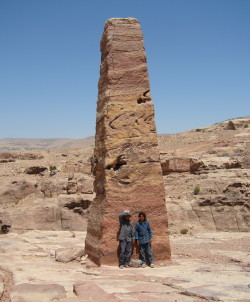 Photo.
Photo. One
of of the Obelixes on the top of Little Petra. © Travel Explorations.
Petra, the "Rose-Red City" of the ancient Nabataean civilization, is situated
in the south of Jordan. It lies to the east of Wadi Araba, a part of the Great
Rift Valley, approximately 133 kilometers as the crow flies from the shores of
the Gulf of Aqaba.
Petra means "rock" in Greek. Since the city is literally carved out
of sandstone desert cliffs, the name fits well. It was founded by a nomadic Arab tribe
known as the Nabataeans several centuries before Christ's birth. The Nabataeans were renowned for
their great skills in trade, agriculture, engineering, and architectural stone-carving.
Ufortunately the ancient city has been damaged seriously due to several
earthquakes, and has not been fully
recoverd. Excavations, reconstructions and conservation work today
intent to make it look like as it did in the past.
Petra's monuments are scattered over 400 square miles. It`s accessible
through a narrow gorge near the village Petra, but it could also be entered by
an old secret trail. This ancient site was unknown for Europeans until it was
rediscovered in 1812 by the Swiss explorer Johann Ludwig Burckhardt.
|
Photo. Stein
Morten walking the old secret trail.
It was definitely not the easiest way!
© Travel
Explorations. |
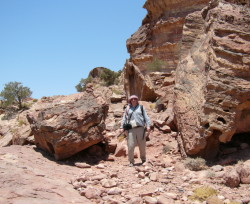 |
It took me about 35 - 40 minutes to climb up to the High Place of Sacrifice
with approximately 1050 steps. Nearby I found the Obelix standing in its full
pride. I just wonder: what was the purpose of this monument? So far little is
known about the Obelix, and it`s still a mystery why and how it was built.
Photo. The High Place of
Sacrifice.
© Travel Explorations. |
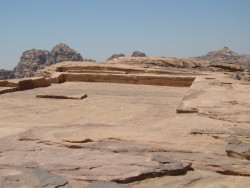 |
Photo. The two Obelixes
on the top of Little Petra.
© Travel Explorations. |
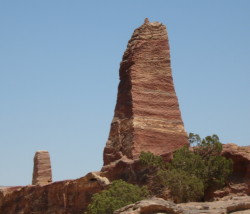 |
Photo. A wonderful view of a part
of Little Petra from the top near the Obelixes and the High
Place of Sacrifice.
© Travel Explorations. |
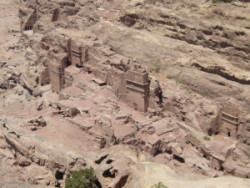 |
More about the Obelix is coming soon!
Stein Morten Lund, 30 August 2005
Additional
information
